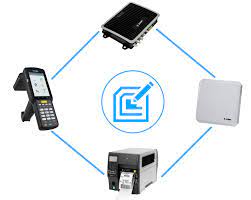RFID stands for radio frequency identification, which is a technology that uses radio waves to identify and track objects. An RFID system consists of an RFID tag, which is attach to the object being track, and an RFID reader, which is use to read the information store on the tag. The reader uses radio waves to communicate with the tag and retrieve the information stored on it.
RFID, or radio frequency identification, is a technology that uses radio waves to identify and track objects. A complete RFID solution typically consists of several key components that work together to enable real-time tracking and identification of objects. Here are the main components of an RFID solution:
RFID Tags:
RFID tags are small electronic devices that contain an antenna and a microchip. The microchip stores information about the object to which the tag is attach, and the antenna is use to transmit this information to an RFID reader. A RFID tags come in a variety of sizes and types, depending on the specific application.
RFID Readers:
RFID readers are devices that use radio waves to communicate with RFID tags. They are use to read the information store in the microchip on the RFID tag and transmit this information to a computer or other data processing device. RFID reader can handheld, mounted on a fix location, or integrated into other devices such as mobile computers.
Antennas:
RFID antennas are used to transmit and receive radio waves between RFID tags and readers. UHF Antenna come in a variety of sizes and shapes and can be designed for specific applications. They are typically mounted on a fixed location, such as a wall or ceiling, or integrated into other devices.
Middle ware:
A Middle ware is software that acts as a bridge between the RFID hardware and other systems such as inventory management or asset tracking systems. Middle ware enables real-time tracking and identification of objects and provides data to other systems in real-time.
Software Applications:
RFID software applications are use to manage and analyze data collect from RFID tags and readers. They can use to track inventory, monitor assets, and provide real-time visibility into the location and status of objects.
Network Infrastructure:
RFID solutions typically require a network infrastructure to enable real-time communication between RFID readers, tags, and other devices. This may include wired or wireless networks, depending on the specific application.
Integration Services:
Integration services are use to integrate RFID solutions with existing systems and processes. This may include integrating RFID data with inventory management systems, asset tracking systems, or other data processing systems.
Conclusion:
RFID solutions consist of a variety of components that work together to enable real-time tracking and identification of objects. By combining RFID tags, readers, antennas, middleware, software applications, network infrastructure, and integration services, businesses and organizations can achieve greater efficiency, accuracy, and productivity in a variety of industries and applications.
